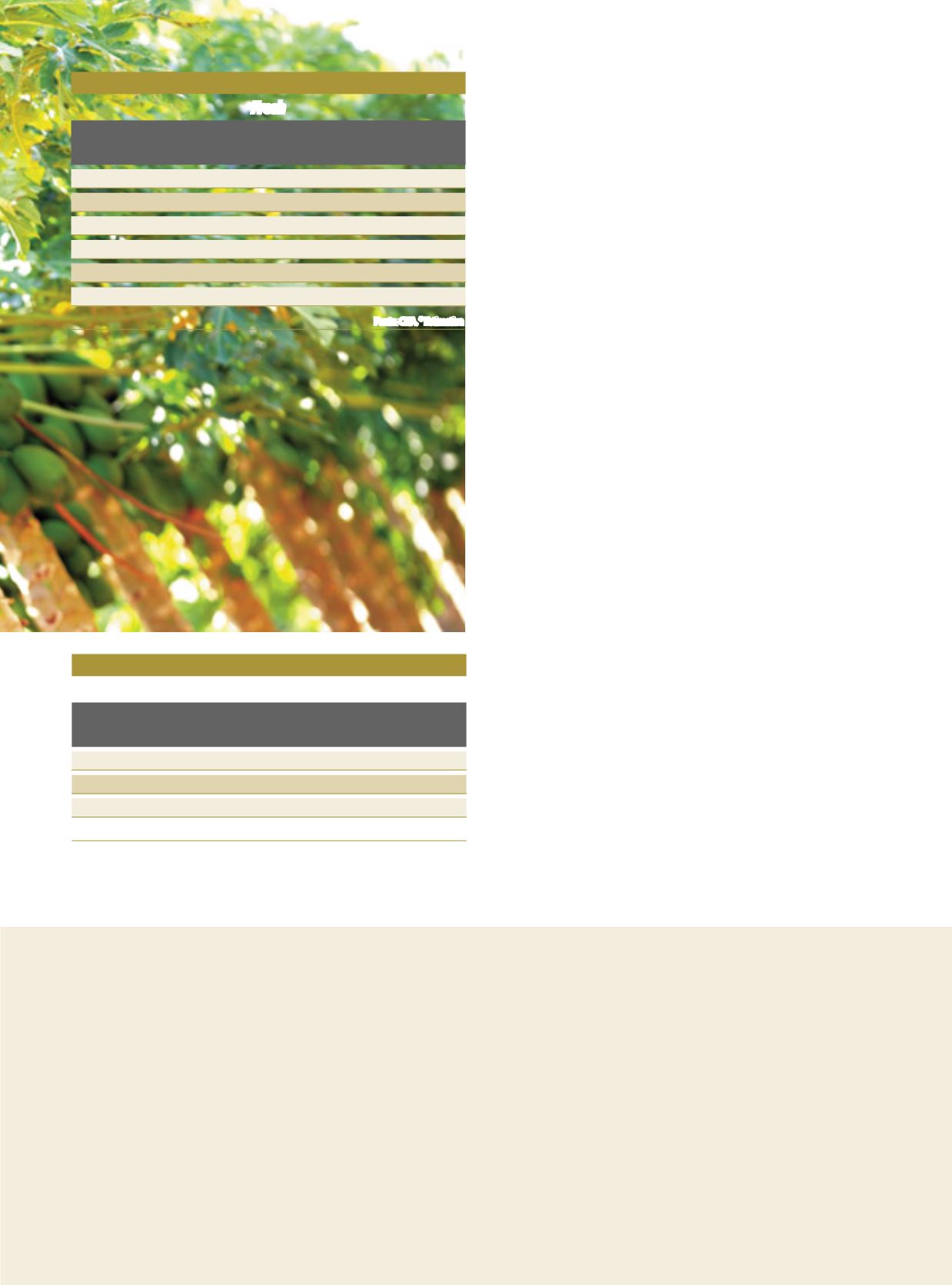
AONATURAL
Fresh
Produçãobrasileiradefrutasfrescas
eexportaçãodefrutasfrescasesecas
Ano
Volume (milhõesdet)
Exportação(milt)
2016*
43,8
836
2015
44,3
819
2014
42,4
708
2013
43,6
711
2012
41,6
693
Fonte:CNA.*Estimativa.
EMBARQUES
Shipments
Exportaçãodefrutasbrasileiradefrutasfrescas
esecas,semnozesecastanhas
Período
Receita(US$)
Volume(kg)
Jan/Nov2016
770.973.907
726.767.936
Jan/Nov2015
775.489.960
801.615.264
Fonte:Agrostat/Mapa–dezembrode2016.
VALORIZADO
O espaço destinado ao plantio de frutíferas totalizou 2,633
milhões de hectares em 2015, contra 2,675 milhões de hectares
no ano anterior, conforme a Pesquisa Agrícola Municipal (PAM),
do Instituto Brasileiro de Geografia e Estatística (IBGE). O le-
vantamento abrange 22 frutas, sendo três classificadas como
lavouras temporárias (abacaxi, melancia e melão) e 19 como
permanentes (abacate, banana, caqui, castanha-de-caju, co-
co-da-baía, figo, goiaba, laranja, limão, maçã, mamão, manga,
maracujá, maemelo, noz, pera, pêssego, tangerina e uva). O va-
lor da produção destas frutas foi avaliado em R$ 26,5 bilhões
em 2015, com acréscimo de 3,4%.
HIGHLYVALUED
The area destined for fruit trees totaled 2.633 million hectares
in 2015, against 2.675 million hectares the previous year, from a
survey by Municipal Agricultural Research (PAM, in the Portuguese
acronym), of the Brazilian Institute of Geography and Statistics
(IBGE). The survey covers 22 fruit species, three of them are classi-
fied as seasonal crops (pineapples, watermelons andmelons), and
19 species are seen as permanent crops (avocado, banana, per-
simmon, cashew nut, Bahia coconut, fig, guava, orange, lemon,
apple, papaya, mango, passion fruit, quince, nut, pear, peach, tan-
gerine and grape). The value of the production of these fruit was
reckoned at R$ 26.5 billion in 2015, up 3.4%fromthe previous year.
Projections indicate bigger supply, consumption and exports in 2017
EXTERNALPORTION
The quality and diversity of the fruit produced in Brazil
make them greatly competitive in all major fruit scenarios, say
CNA officials. Before the end of 2016, up to the months of Sep-
tember, the forecast was for exports to amount to 836 thou-
sand tons of fruit this year, up 3% from the volume shipped
abroad in the previous year. The performance, including nuts
and cashew nuts, totaled 726.767 thousand tons and US$
770.973 million, from January through November 2016, ac-
cording to Agrostat/Mapa. Considering the same period in
2015, the result suffered a reduction of 74.847 thousand tons
and US$ 4.516 million.
Even so, the perspective is for the volume sent in 2016 to
go up a little, taking advantage of new foreign clients, accord-
ing to the Brazil Hortifrutis Yearbook - Retrospective 2016 &
Perspective 2017. The publication is by the Center for Applied
Studies on Advanced Economics (Cepea), of the University of
São Paulo (USP). According to the yearbook, the appreciation
of the dollar reduced the prices and revenue in North-Amer-
ican currency, but pushed up the amount received in Brazil-
ian currency. On the other hand, fruit imports tend to recede
in 2016 and 2017, as a result of weak domestic demand and an
appreciated dollar.
CNA is projecting significant increases in exports in 2017.
This will stem from Brazil’s capacity to trade fresh and pro-
cessed fruit, along with government and private sector’s initia-
tives in giving publicity to the quality of the national fruit and
market expansions. For example, since 2014, the Brazilian Fruit
project has been lending support to the national exporters ea-
ger to find their way into new markets, acknowledgement and
differentiation of Brazilian fruit, whilst boosting people’s fruit
consuming habit, always focused on superior quality fruit. The
Brazilian Fruit Growers and Exporters Association (Abrafrutas)
is developing the project, in a partnership with the Brazilian
Trade and Investment Promotion Agency (Apex-Brasil).
53


